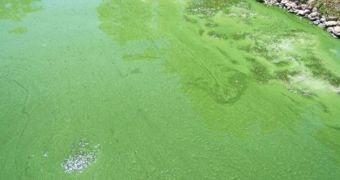Over the course of the planet's history, there have been five extinction events that scientists know of, and each and every single one of them may have been caused by nothing more than algae. The new idea was proposed by a scientist on October 19, at the annual Geological Society of America meeting. As expected, his idea immediately sparked a heated controversy, LiveScience reports.
Most scientists believe that the events may have been caused by an asteroid impacting our planet. The debris kicked in the atmosphere, coupled with the shock waves and the widespread fires that would have ensued, might have killed off many of the Earth's species. Some experts believe that the extinction events were caused by exploding supervolcanoes and massive tremors that suddenly and abruptly reshaped the world's map. There are, of course, those who believe that the extinctions took place on account of both of these scenarios happening at the same time.
The cataclysmic events, which claimed the lives of between 50 and 90 percent of the world's species, span a period of time between 540 million years ago and 65 million years ago. According to the fossil record, and other telltale signs, the five events occurred as follows:
1. 440 to 450 Ma ago – the Ordovician–Silurian extinction 2. 360 to 375 Ma – the Late Devonian extinction 3. 251 Ma – the Permian–Triassic extinction 4. 205 Ma – the Triassic–Jurassic extinction 5. 65 Ma – the Cretaceous–Tertiary extinction event.
In all of these instances, Clemson University geologist James Castle and CU environmental toxicologist John Rodgers believe, toxins generated by mass algal blooms might have played a crucial role, tilting the balance towards disaster. Some species of these organisms are known to produce chemicals that are harmful to other aquatic species, and even to land-dwelling animals and birds. When they have sufficient nutrients, the amounts of toxins they produce increase considerably. This stage of development is known as a “bloom.”
“Since they've changed very little in their structure, and they make toxins today, we propose that they did so in the past,” Castle says of a specific type of organisms, called cyanobacteria. Some researchers still think they are algae, while others have reclassified them as bacteria. There could have also been a number of alga species that left no fossils, the two add. The toxins these algae might have produced could have spread to the plants, thus making their way into the animals' diets, causing them to die en masse.
“The toxins tend to become stronger and released when there's something that stresses the algae, [such as] a change in salinity of the water, a change in temperature. There could have been an impact or volcanic eruption, and that may have stressed the algae, [and] by changing the conditions, they released toxins that kill the organisms. [The new idea] does not exclude any of the other hypotheses for mass extinction,” Castle says.
Not everyone is convinced that the new idea stands scientific scrutiny. For example, University of California in Santa Cruz (UCSC) marine paleoecologist Matthew E. Clapham, who has been studying the Permian-Triassic extinction event for a long time, says, “Because cyanobacteria have been around for most of the history of life on Earth, it's virtually certain that there were times in the past when there were local die-offs due to cyanobacterial toxins. But to demonstrate that it was a global event, or something significant enough, I'm not sure that that's likely.”

 14 DAY TRIAL //
14 DAY TRIAL //